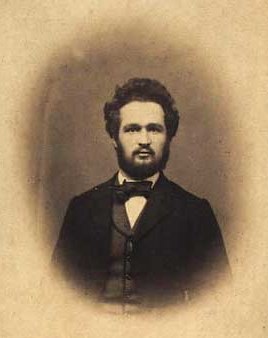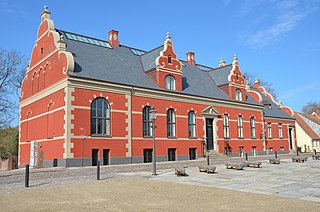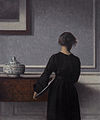
Christen Schiellerup Købke was a Danish painter, and one of the best-known artists from the Golden Age of Danish Painting.

Laurits Andersen Ring was one of the foremost Danish painters of the turn of the 20th century, who pioneered both symbolism and social realism in Denmark. Considered one of the masterpieces of Danish culture, his painting Summer Day by Roskilde Fjord was included in the 2006 Danish Culture Canon.
The Danish Golden Age covers a period of exceptional creative production in Denmark, especially during the first half of the 19th century. Although Copenhagen had suffered from fires, bombardment and national bankruptcy, the arts took on a new period of creativity catalysed by Romanticism from Germany. The period is probably most commonly associated with the Golden Age of Danish Painting from 1800 to around 1850 which encompasses the work of Christoffer Wilhelm Eckersberg and his students, including Wilhelm Bendz, Christen Købke, Martinus Rørbye, Constantin Hansen and Wilhelm Marstrand, as well as the sculpture of Bertel Thorvaldsen.

The National Gallery of Denmark is the Danish national gallery, located in the centre of Copenhagen.

Theodor Esbern Philipsen was a Danish painter of Jewish ancestry; known for landscapes and animal portraits. He also did small figures in wax and clay.

Ordrupgaard is a state-owned art museum situated near Jægersborg Dyrehave, north of Copenhagen, Denmark. The museum houses one of Northern Europe's most important collections of Danish and French art from the 19th and beginning of the 20th century.

Peter Ilsted was a Danish printmaker and painter. He was most associated with domestic interior scenes.

Ribe Kunstmuseum is an art museum in Ribe, Denmark.
Danish art is the visual arts produced in Denmark or by Danish artists. It goes back thousands of years with significant artifacts from the 2nd millennium BC, such as the Trundholm sun chariot. For many early periods, it is usually considered as part of the wider Nordic art of Scandinavia. Art from what is today Denmark forms part of the art of the Nordic Bronze Age, and then Norse and Viking art. Danish medieval painting is almost entirely known from church frescos such as those from the 16th-century artist known as the Elmelunde Master.

The Hirschsprung Collection is an art museum located on Stockholmsgade in Copenhagen, Denmark. It is located in a parkland setting in Østre Anlæg, near the Danish National Gallery, and houses a large collection of Danish art from the 19th and early 20th century. The emphasis is on the Danish Golden Age, from 1800 to 1850, but also the Skagen Painters and other representatives of the Modern Breakthrough are well represented.

Fuglsang Art Museum is an art museum set in rural surroundings in Guldborgsund Municipality on the island of Lolland in Denmark. It is part of the Fuglsang Cultural Centre. The museum features Danish art with an emphasis on artists and motifs of local provenance.
Niels William Scharff was a Danish painter, one of the leading proponents of Cubism in Denmark.

Den Frie Udstilling is a Danish artists' association, founded in 1891 by artists in protest against the admission requirements for the Kunsthal Charlottenborg. Modeled on the Salon des Refusés, it is Denmark's oldest association of artists. Now located on Copenhagen's Oslo Plads next to Østerport Station, it works as an arts centre, continuing to exhibit works created and selected by contemporary artists rather than those chosen by cultural authorities.

Johan Gudmann Rohde was a Danish painter, lithographer and designer. He was the principal founder of Den Frie Udstilling, established in 1891 to allow artists to exhibit works which did not fall within the Academy's selection criteria.
Hans Christian Rylander was a Danish painter, educated at the Royal Danish Academy of Fine Arts from 1965 to 1969. He used an expressive and surreal style, in the 70's and 80's with a critical edge towards society. Rylander exhibited his works at the Randers Museum of Art, at Storstrøms Kunstmuseum, and at Vejle Museum of Art. A major commission was the decoration in Christian IV's Supply Depot at Slotsholmen in Copenhagen. Rylander received the Eckersberg Medal in 1984.

Nivaagaard is a historic property in Nivå in the northern outskirts of Copenhagen, Denmark. It is now home to an art gallery and the park is open to the public.

Interior with Young Woman Seen from the Back is an oil-on-canvas painting from c. 1903–04 by the Danish artist Vilhelm Hammershøi. It is now held in the Randers Museum of Art. It uses the muted grey-blue palette, uncluttered composition and detailed attention to the play of light typical of Hammershøi's work.

Suzette Catherine Holten was a Danish painter and ceramist who belonged to the Skovgaard family of artists. In addition to landscapes, flower paintings and portraits, she created and decorated ceramics and also worked as an embroiderer. As a woman, she was unable to achieve the same level of acclaim as her father or brothers.

A Nude Woman Doing her Hair before a Mirror is an oil painting from 1841 by the Danish Golden Age painter CW Eckersberg. The painting is in the Hirschsprung Collection in Copenhagen. The relatively small image is regarded as one of the masterpieces of the Danish Golden Age, and is also one of the Hirschsprung Collection's 20 most important works.


























